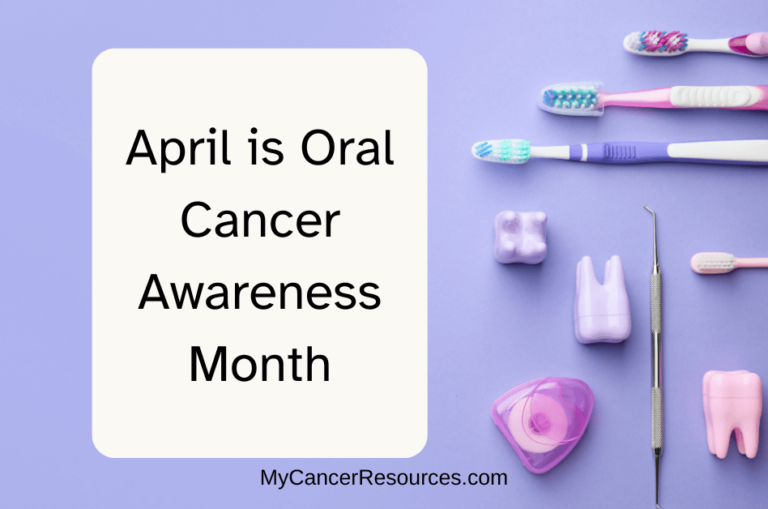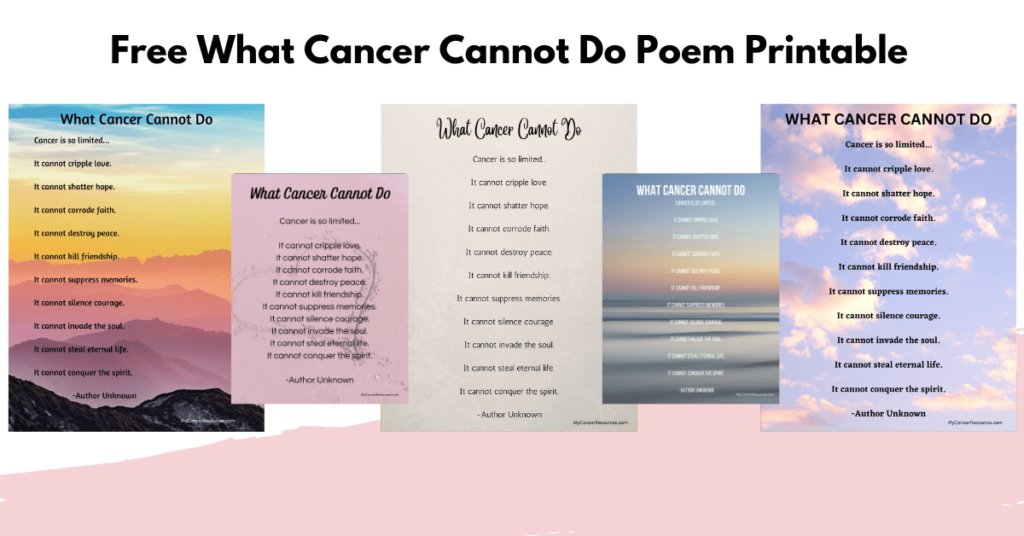
April is Oral Cancer Awareness Month. Oral cancer is often lumped in as Oral, Head, and Neck cancers, but for this post, I’m just going to focus on oral cancer.
You may have also heard of Mouth Cancer Action Month, which is held in November in the United Kingdom.
It, too, focuses on raising awareness of mouth cancer. For statistics on oral cancer in the UK, check out the Mouth Cancer Foundation website.
Understanding Oral Cancer
Of all the head and neck cancers, oral cancer makes up about 85% of those cases.
Oral cancer includes cancer of the tongue, the gums, and the floor of the mouth. Cancer on the roof of the mouth, also called the hard palate, is also considered oral cancer.
This group of cancer also includes cancer of the lips and the minor salivary glands.
Even though the soft palate (the part at the back of the mouth with the uvula, the thing that hangs down) is considered by many to be part of the mouth, some of its purpose is to help breathe and swallow, so it’s considered to be an upper throat cancer.
Oral cancer is often diagnosed after it has spread to other parts of the body, making it more difficult to treat.
One of the most distressing parts of oral cancer can be long-term problems including difficulty talking and swallowing, and severe facial disfigurement from surgeries to remove tumors.
Types of Oral Cancers
There are a few different types of oral cancers, but about 90% of them are squamous cell carcinomas.
A couple other rare types of oral cancer are called adenoid cystic carcinoma (ACC) and mucoepidermoid carcinoma (MEC).
Not as much is known about these other types of cancer. They are rare, and harder to treat than the squamous cell type of cancer.
Statistics/Fast Facts
The American Cancer Society groups both oral cavity and oropharyngeal cancer together in their statistics. This is cancer of the mouth and also cancer of the upper throat.
This year, around 58,450 new cases will be diagnosed, and there will be about 12,230 deaths.
This means this disease kills about one person every hour of the day, 365 days a year.
It is twice as common in men as in women.
Blacks are twice as likely as whites to develop oral cancer.
Most of the time, oral cancer is found only after it has spread (metastasized) to another part of the body, often the lymph nodes in the neck. It is much harder to treat oral cancers once they have spread.
The average age of diagnosis was usually in people over 40, but it is now becoming more common in younger people.
Risk Factors
About 25% of people with oral cancer have no known risk factors. The major risk factors for developing oral cancer are:
Tobacco use – it doesn’t matter what type of tobacco products are used – smoking, vaping, and chewing tobacco can all lead to oral cancer.
Alcohol use – When tobacco users also drink alcohol, the combination increases the risk of developing oral cancer 15 times more than just using tobacco or alcohol.
Human Papillomavirus (HPV) infection This is a sexually transmitted infection.
The strain HPV16 is strongly linked to the development of oral cancer in young, nonsmoking people with cancer. This is the fastest-growing cause of oral cancer.
The HPV virus also causes more than 90% of all cervical cancer and other cancers too.
The HPV vaccine was developed in hopes that it would prevent these cancers from developing over time.
If you have HPV, you’re 30 times more likely to develop oral cancer than someone without HPV infection.
Sun exposure – whether outdoors or from a tanning bed, exposure to UV rays is a risk factor for developing cancer on the lip.
Signs and Symptoms of Oral Cancer
Here are some of the most common symptoms of oral cancer:
- A sore in the mouth or on the lip that does not heal
- Ongoing mouth pain
- A lump or thickening on the lips, gum or in the mouth
- A red or white patch on the gums, tongue or inner lining of the cheeks
- A change in your voice
- Loose teeth or dentures
- Trouble chewing, swallowing, or moving the jaw or tongue
- Ongoing feeling that something is stuck in the throat
- Numbness in the tongue
- A lump in the neck
- Persistent bad breath
How Oral Cancer is Diagnosed
There is no formal screening program in the U.S. to detect oral cancer.
The American Association of Oral and Maxillofacial Surgeons has created this handy self-exam guide.
Along with regularly checking the inside of your mouth for signs, keep up with routine visits to the dentist so they can also look for anything that may be out of the ordinary.
Treatment
Oral cancers are often treated with one or more of the following:
- surgery
- radiation
- chemotherapy
- immunotherapy
Conclusion
This April, for Oral Cancer Awareness Month, have a regular dental check-up. These should be done every six months.
Dental professionals are well-trained in looking for the possible signs of oral cancer.
Many dentists offer free oral cancer screenings during April if you can’t get in for a regular check-up and cleaning.
Take advantage of these opportunities in your community and encourage those who are at greater risk to get checked out as well.
Regular oral cancer examinations are the most effective way to discover potential issues and hopefully lead to an early detection of oral cancer.
Help raise public awareness. Many don’t realize that nonsmoking individuals can be at high risk for developing oral cancer, particularly if they have HPV, regularly drink alcohol or have had a lot of sun exposure over their lifetime.
Raising awareness is the first step, so people can be more proactive about reducing risky behaviors and keeping up with dental visits for screenings.



